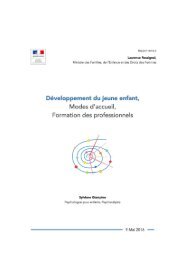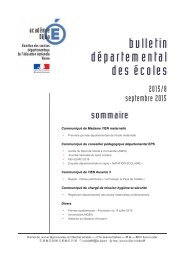agrl_innovations_in_ssa.pdf?utm_content=buffercb41d&utm_medium=social&utm_source=twitter
agrl_innovations_in_ssa.pdf?utm_content=buffercb41d&utm_medium=social&utm_source=twitter
agrl_innovations_in_ssa.pdf?utm_content=buffercb41d&utm_medium=social&utm_source=twitter
You also want an ePaper? Increase the reach of your titles
YUMPU automatically turns print PDFs into web optimized ePapers that Google loves.
especially <strong>in</strong> the ca<strong>ssa</strong>va-grow<strong>in</strong>g areas <strong>in</strong> the south of the country. This was compounded<br />
by Nigeria’s reliance on oil exports, which had triggered an abrupt fall <strong>in</strong> production <strong>in</strong> the<br />
agriculture sector, result<strong>in</strong>g <strong>in</strong> large scale rural–urban migration and rapidly ris<strong>in</strong>g urban wages<br />
supported by cheap rice and wheat imports to meet grow<strong>in</strong>g urban demand. Unfortunately the<br />
agricultural sector rema<strong>in</strong>ed largely subsistence and failed to keep up with rapid population<br />
growth. With high dependence on food imports and oil dom<strong>in</strong>at<strong>in</strong>g the economy, the price of<br />
ca<strong>ssa</strong>va rema<strong>in</strong>ed depressed and production fell. However, by the mid-1980s, petroleum-led<br />
economic growth had slowed and the Government <strong>in</strong>troduced a structural adjustment<br />
programme that devalued the Naira and lifted subsidies on fertiliser and cereals. This resulted<br />
<strong>in</strong> dramatically improved <strong>in</strong>centives for ca<strong>ssa</strong>va growers. Real producer prices <strong>in</strong>creased as a<br />
consequence of devaluation, the abolition of commodity boards, and import restrictions on<br />
selected foodstuffs and animal feeds. As a result, consumer demand changed from such foods<br />
as bread, eggs, meat and rice towards such locally produced staples as ca<strong>ssa</strong>va, maize, sorghum<br />
and yams. Farmers responded by produc<strong>in</strong>g more of these crops. Despite this response, many<br />
areas still suffer from seasonal food deficits. This prompted Government to seek policies to<br />
enhance agricultural productivity, thus encourag<strong>in</strong>g collaboration with <strong>in</strong>ternational agencies<br />
and NGOs to develop the ca<strong>ssa</strong>va sector.<br />
Innovation triggers. PICPE launched <strong>in</strong> 2003 brought ca<strong>ssa</strong>va and its potential <strong>in</strong>to the<br />
national limelight. PICPE’s goal was to stimulate ca<strong>ssa</strong>va production to become a viable foreign<br />
exchange earner. The challenge was that by 2007 the country should earn US$5 billion from<br />
value-added ca<strong>ssa</strong>va exports. Nigeria’s M<strong>in</strong>istry of Trade and Commerce commissioned the<br />
United Nations Industrial Development Organization (UNIDO) to assist <strong>in</strong> the development of<br />
a Ca<strong>ssa</strong>va Master Plan. This Plan identified and analysed the ca<strong>ssa</strong>va value cha<strong>in</strong>, propos<strong>in</strong>g:<br />
bus<strong>in</strong>ess development, <strong>in</strong>ternational economic cooperation and scientific support <strong>in</strong>itiatives,<br />
and benchmark<strong>in</strong>g the Nigerian ca<strong>ssa</strong>va sector aga<strong>in</strong>st compet<strong>in</strong>g ca<strong>ssa</strong>va nations, particularly<br />
Thailand and Brazil.<br />
The National Economic, Empowerment and Development Strategy (NEEDS) (National Plann<strong>in</strong>g<br />
Commission, 2004) recognised the importance of agriculture, despite the dom<strong>in</strong>ant role of<br />
oil as the country’s ma<strong>in</strong> export. Accord<strong>in</strong>gly, Government committed three percent of the<br />
national budget to agriculture, aim<strong>in</strong>g at six percent growth for the sector <strong>in</strong> order to restore<br />
agriculture to its former status as a lead<strong>in</strong>g sector <strong>in</strong> the economy. The ma<strong>in</strong> challenges were<br />
to <strong>in</strong>crease economic opportunities through susta<strong>in</strong>able and competitive ca<strong>ssa</strong>va production,<br />
process<strong>in</strong>g, market<strong>in</strong>g, and agri-enterprise development <strong>in</strong> selected communities by:<br />
• Increas<strong>in</strong>g ca<strong>ssa</strong>va productivity by develop<strong>in</strong>g improved germplasm, soil amendments,<br />
<strong>in</strong>tegrated pest management (IPM), and other proven best practices<br />
• Mitigat<strong>in</strong>g the impact of CMD through participatory evaluation, multiplication, and<br />
distribution of CMD-resistant germplasm to farmers<br />
• Develop<strong>in</strong>g and expand<strong>in</strong>g postharvest process<strong>in</strong>g, and market<strong>in</strong>g outlets for ca<strong>ssa</strong>va<br />
products to <strong>in</strong>crease <strong>in</strong>comes and improve livelihoods <strong>in</strong> rural areas.<br />
Interventions and stakeholder roles. In 2003 PICPE tasked a commission to f<strong>in</strong>d ways of<br />
<strong>in</strong>creas<strong>in</strong>g annual ca<strong>ssa</strong>va production, process<strong>in</strong>g and export from 32 million to 150 million<br />
tonnes <strong>in</strong>creas<strong>in</strong>g the value added <strong>in</strong> ca<strong>ssa</strong>va production from US$ 1 billion to US$ 5 billion<br />
76 Agricultural Innovation <strong>in</strong> Sub-Saharan Africa






